Once widely maligned as “Tupperware,” the polymer pistol now rules the shooting world to the point where the writer of this article, who is also a very active trainer and LTC instructor, has many students say they’ve never shot an all-metal handgun. And some are also not personally familiar with the revolver, regardless of composition. So, our Houston testers wondered if the 38 Special wheelgun is practically dead, or can it still serve a useful purpose as a viable every-day carry handgun when so many good semi-automatic 9mm pistols exist.
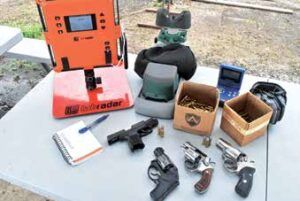
To find out, we chose the SIG Sauer P365, perhaps the hottest-selling handgun in this country, as a benchmark against which to compare some new and not-so-new revolvers. The baseline we tested against was a SIG P365 365-9-BXR3 9mm Luger, $599. As a value proposition, we started off the revolver part of the tests with an older S&W Model 60 38 Special, $459. The closest modern equivalent of the 1978-version Model 60 is a blued Model 36 150184 38 Special, $809. Next, we included a Ruger LCR 5401 38 Special +P, $699. Last was a Ruger SP101 5737 38 Special, $859. Someday, the ammo drought will end, but because we’re not there yet we once again used properly assembled reloads for the revolvers. We tried to get a little extra speed with those short barrels, so we used 125-grain bullets. The first we tried was Hunter’s Supply hard-cast lead flat point from MidwayUSA.com (418579, $15/100). We also shot Hornady’s 125-grain XTP (490514, $24/100). For the SIG P365 9mm, we used SIG Sauer’s 115-grain V-Crown (MidwayUSA.com 966280, $22.50/20) and 9mm Remington Range ammo (542116, $30/50).
Keeping in the mind the assumed use of these handguns was for self defense, accuracy testing was done at 7 yards. Even though two of the three revolvers allowed single-action shooting, all testing for accuracy and speed was performed double action only. Group shooting consisted of multiple five-shot strings fired from a well-weighted Caldwell Pistolero shooting rest (MidwayUSA.com 562771, $30). Muzzle velocities were obtained via a LabRadar chronograph. All shooting was done at American Shooting Centers in west Houston. Here’s how the handguns performed.
Gun Tests Grade: B+
$459
Smith & Wesson didn’t start using model numbers until 1957. Now, anything beginning with a 4 (and sometimes 5) is blued steel. Our 1978-vintage 38 Special is a Model 60, denoting that it is made of stainless steel. As modifications were made with a particular model, “dash” numbers were added, as in 60-2 or 60-3. Our sample is a “no dash,” meaning it was one of the earliest versions of that pistol. For proper self-defense use, its age really doesn’t mean that much unless wear or misuse has damaged some critical component in some way. Ours was in good shooting shape, though some exterior scratches marred the finish. Perhaps you can get $50 off the sales price because one you’re considering is scratched.
| Action Type | Double-action and single-action revolver |
| Overall Length | 6.25 in. |
| Overall Height | 4.2 in. |
| Maximum Width | 1.31 in. |
| Weight Unloaded | 1.2 lbs. |
| Weight Loaded | 1.35 lbs. |
| Receiver | Brushed stainless steel |
| Front Strap Height | 2.0 in. |
| Back Strap Height | 3.25 in. |
| Barrel Length | 1.875 in. |
| Grip Thickness (Maximum) | 1.18 in. |
| Grip Circumference | 4.0 in. |
| Cylinder Capacity | 5 rounds |
| Front Sight | Fixed serrated ramp |
| Rear Sight | Groove in top strap |
| Sight Radius | 3.4 in. |
| Trigger Pull Weight (Double Action) | 12+ lbs. |
| Trigger Span | 3.4 in. |
| Safety | Rebounding hammer |
| Warranty | Limited |
| Telephone | (800) 331-0855 |
| Made in | USA, MA |
This Model 60 has a 1.875-inch-long barrel and sports a five-shot cylinder. The minimalist sights consist of a groove milled in the top strap, along with a ramped front sight. Both are the same stainless steel as the rest of the revolver and neither are adjustable.
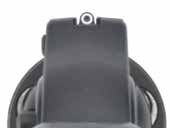
More-modern S&W revolvers have a frame-mounted firing pin that is hit by the hammer at the end of the hammer’s forward travel. This Model 60 still has the hammer-mounted firing pin. It also shows a pinned cylinder, which makes sure the cylinder doesn’t loosen under repeated firings. This was determined, eventually, to be unnecessary, but we like over-built.
The cylinder is opened by pushing a checkered release on the left side of the frame forward, allowing it to swing out to the left. In keeping with the small nature of the handgun, the extractor rod is fairly short, sometimes to the point that empties don’t clear the cylinder when ejection is attempted and have to be removed by hand. Save your old toothbrushes for cleaning the inside of the extractor star. Various kinds of residue can build up between the extractor and the face of the cylinder. Enough build up will eventually cam the extractor against the breech face, making it almost impossible to rotate the cylinder. It’s pretty easy to prevent this problem with a minor amount of maintenance.
The small round-butt grips on our J-Frame S&W are easy to hide, but they don’t give all that much to hold onto. As a result, this small revolver can move in your hand under recoil, sometimes smacking the knuckles of the middle finger. That can get old quickly.
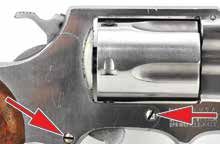
The hammer has an extended checkered cocking piece that is not as easy to hide and can foul in the pocket when drawn. We have seen many small revolvers modified by shortening the hammer spur or removing it entirely. That, of course, prevents single-action shooting, which isn’t that practical in defensive situations anyway. That means it shouldn’t be done that much in practice, either. S&W revolvers tend to come with mediocre triggers. Under the ministrations of a good gunsmith, however, they can be turned into an incredibly smooth work of art. Ours has not and is in as-issued condition, with the double-action pull measuring more than the 12-pound limit of our Lyman Gauge.
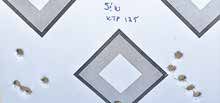
A good revolver shooter learns to stroke the double-action trigger, rotating it smoothly in a medium-speed rhythmic movement. When accomplished correctly, the revolver is very easy to shoot accurately and quickly. Jerk the trigger and that heavier pull is going to have you waving it around so that you’ll be lucky to hit much. This Model 60 reminded us that it can, in fact, shoot very well. The sights were the best regulated of the three revolvers tested, hitting center on the target and a bit low. It also reminded us that a little bit of extra weight can be an advantage. Lightweight revolvers tend to smack the palm, and the extra 6 ounces of weight in the Model 60 versus the Ruger LCR produced noticeably lighter recoil.
Our Team Said: As a firearm that could spend a lot of time in pockets or even down in the dirt inside an ankle holster, we really liked the Model 60’s stainless-steel construction. Just that little bit of extra weight from the steel over polymer materials made a difference in handling recoil.
Bottom Line
In our tests, the SIG Sauer P365 shot more quickly, was a bit easier to shoot accurately, recoiled a bit less, concealed more easily, and carried a higher round count of somewhat more powerful ammunition. It would appear that we have destroyed our own argument about the viability of the snub-nosed revolver in the modern shooting world, except in the areas of dependability and simplicity of deployment. We believe those are important considerations. To wit:
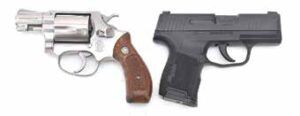
Semi-automatic pistols are more likely to malfunction than revolvers. Making sure your Pocket 9 is well-maintained will mitigate a large percentage of potential problems. If it does jam, a little bit of training and a solid “Slap, Rack, Bang” will fix most of the things that can go wrong. With the revolver, however, simply pull the trigger again.
Semi-autos can be more sensitive to ammunition selection and fundamentals of grip and stance. Don’t lock the arms out, and the auto can malfunction. Feed it the wrong ammo, and it can malfunction. The revolver doesn’t care if you put five different kinds of old ammo in there. If it doesn’t work, press the trigger again. We have done many demos where we held the revolver upside down and activated the trigger with our little finger. We are less likely to be accurate, of course, but the revolver didn’t care.
Many law-enforcement officers carry a small revolver in an ankle holster. Yeah, ankle holsters are itchy and uncomfortable when you first wear them, but so are inside-the-waistband holsters. That ankle holster leaves the backup gun down close to the dirt. Do an informal survey sometime and ask police officers whether they are willing to trust their lives to a semi-auto or a revolver that is likely to get dirty. A quick note on the ankle holster for the average citizen — they work very well for someone who drives a lot. Puts that handgun in an accessible location.
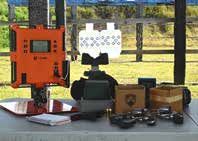
Those with less-than-optimal hand strength may find the semi-auto slide hard to rack and the manual of arms more difficult to perform. The operating procedures on the revolver are simple and few — open the cylinder, load the cylinder, close the cylinder, press trigger. We readily acknowledge that those with diminished hand strength might also find issue with the longer, and frequently heavier, trigger pull required from the revolver.
What if you have the semi-auto in a purse or coat pocket with an absolute need to shoot and no time to draw? Press the trigger. In all likelihood, you will get one shot off before the slide fouls in the pocket and the gun malfunctions. The revolver doesn’t care. Press the trigger again as necessary.
If, heaven forbid, a good guy or gal has to defend themselves at contact distance, pushing the muzzle of a semi-auto into the attacker will force the slide to the rear, rendering the pistol inoperable until that condition is remedied. The revolver doesn’t care. Press the trigger again as necessary.
Is the small revolver the perfect everyday carry gun? No. The snubnosed 38 Special is a tool, a specialized tool, that does some jobs better than just about any other choice. Several of our test group carry Pocket Nines on a daily basis, especially during the summer in Houston. We have no intention of giving them up. But when it gets cold, we carry a 38 Special in a coat pocket because we don’t have time to dig through the other layers to get to the pistol on our belt.
When we carry a second handgun, we carry a 38 Special. When we drive a lot, we carry a 38 Special. We know tons of ladies who carry them in their purses and quite a few other folks that carry a 38 Special off body in a briefcase. We have no intention of trading in our snubbies, but we do realize their increasingly specialized role in concealed carry.
Drill Data (5x9x7)
| Pistol | Time to First Shot (seconds) | Split Average (seconds) | Total Time (seconds) |
|---|---|---|---|
| SIG Sauer P365 9mm Luger | 0.83 | 0.21 | 1.68 |
| S&W Model 60 38 Special | 0.9 | 0.28 | 2.03 |
| Ruger LCR 38 Special | 0.87 | 0.27 | 1.94 |
| Ruger SP101 38 Special | 0.87 | 0.28 | 1.98 |
38 Special Range Data
| Hunter’s Supply 125-grain Lead | S&W Model 60 | Ruger LCR | Ruger SP101 |
| Average Velocity | 792 fps | 790 fps | 820 fps |
| Muzzle Energy | 174 ft.-lbs. | 173 ft.-lbs. | 187 ft.-lbs. |
| Best Group | 1.32 in. | 1.79 in. | 1.38 in. |
| Average Group | 1.62 in. | 2.39 in. | 1.69 in. |
| Hornady 125-grain XTP | S&W Model 60 | Ruger LCR | Ruger SP101 |
| Average Velocity | 827 fps | 842 fps | 863 fps |
| Muzzle Energy | 190 ft.-lbs. | 197 ft.-lbs. | 207 ft.-lbs. |
| Best Group | 1.23 in. | 1.98 in. | 0.61 in. |
| Average Group | 1.34 in. | 2.33 in. | 1.16 in. |
Testing was done at American Shooting Centers in west Houston. Muzzle velocities were determined via a LabRadar chronograph ($559). All shots for group were fired double action from a well-sandbagged Caldwell Pistol Rest from MidwayUSA and aided by a mini-DRC Fortune Cookie bag from Wiebad.com.



























An Apex trigger kit helps with the accuracy by knocking a little weight off of the trigger.
Why the hell can’t I read the review. I’m a 2-3 year current subscriber, and your site keeps telling me to subscribe to the site? WTF?
Mike Schraeder
I bought two Model 60’s way back in the 60’s when they first came out. They have never been fired, and probaby never will. I am getting older now. I live in Fort Worth Texas. Where / how would you advise I sell them?